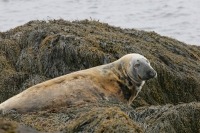
(Photo: Ralph Eldridge)
Grey Seal
Halichoerus grypus
This is a medium-sized seal with a distinctive horse-like head. Their fur is usually some shade of grey with irregular blotches and spots on the back and sides. The muzzle is long and wide at the end, with parallel nostrils set some distance from each other, forming a W pattern. A fleshy area around the whiskers hides the lower jaw. The sexes look different; males are larger than females and have a larger, broader head. Male fur colour darkens as they grow older. Young seals are paler with fewer or no blotches at all. Pups have a white coat as newborns. The top of the muzzle is convex in males and almost flat in females and younger adults. Males can measure up to 2.3 metres in length and weigh up to 350 kilograms. Females are smaller and can measure up to two metres in length and weigh up to 227 kilograms.
Authority
Fabricius, 1791
Classification Details
Phylum: Chordata (chordates); Subphylum: Vertebrata (vertebrates); Class: Mammalia (mammals); Infraorder: Pinnipedia (seals, sealions, and walrus); Family: Phocidae (true seals).
Habitat
A coastal species found on both sides of the North Atlantic Ocean. There are three populations around the world. One is in the Baltic Sea, the second is in the British Isles, Iceland, the Faroe Islands, and Ireland, and the third population is in the western Atlantic. In Canada, their range extends from the Gulf of St. Lawrence off Quebec to New Brunswick, Nova Scotia, Prince Edward Island, and Newfoundland. Their presence in the Bay of Fundy is occasional but increasing. The 3 Canadian grey seal populations have increased over the last 30 years. Sable Island had the greatest increase, followed by the Gulf of St. Lawrence and, to a lesser degree, the coastal Nova Scotia population. They form large groups during breeding and moulting seasons, hauling out onto rocky shores, islands, ice shelves, and icebergs.
Diet
Eat fish such as cod, white hake, flatfish, herring, and skate. Their diet also includes invertebrates such as octopus and lobster. They feed in both inshore benthic (seabed) habitats and in the water column, where they prey on schooling fish. Scientists have found that the mortality of up to 50% of cod is due to predation by grey seals.
Reproduction
Males mate with many females during their breeding season. Mating occurs in large groups. Breeding and pupping takes place from late September to early March. Females give birth to one pup. Pups have a white fur coat known as lanugo, which absorbs sunlight and traps heat to keep them warm. Their diet consists of high-fat milk which enables them to gain about 1.36 kilograms a day. Mothers and pups use calls to find each other in crowded areas. Grey seals have a life span of 25 to 35 years.
Fun Facts
The grey seal's latin name, Halichoerus grypus, means "hook-nosed sea pig."
Grey seals often dive down to 70 metres and can dive as deep as 300 metres. Dives last as long as half an hour.
References
DFO. Grey Seal. http://www.dfo-mpo.gc.ca/species-especes/profiles-profils/greyseal-phoquesgris-eng.html Accessed online 20 January 2020.
Edwards RV (2008) Halichoerus grypus Grey seal. In Tyler–Walters H. and Hiscock K. (eds) Marine Life Information Network: Biology and Sensitivity Key Information Reviews, [on–line]. Plymouth: Marine Biological Association of the United Kingdom. Available from: https://www.marlin.ac.uk/species/detail/1995 Accessed online 20 January 2020.
NOAA. Gray Seal – Species Directory. https://www.fisheries.noaa.gov/species/gray-seal#overview Accessed online 20 January 2020.
Van Guelpen L, Pohle G, Vanden Berghe E and Costello MJ (2005) Marine Species Registers for the North Atlantic Ocean. World Wide Web electronic publication. http://www.vliz.be/vmdcdata/narms/
The Wildlife Trusts. Grey seal. https://www.wildlifetrusts.org/wildlife-explorer/marine/marine-mammals-and-sea-turtles/grey-seal Accessed online 20 January 2020.


